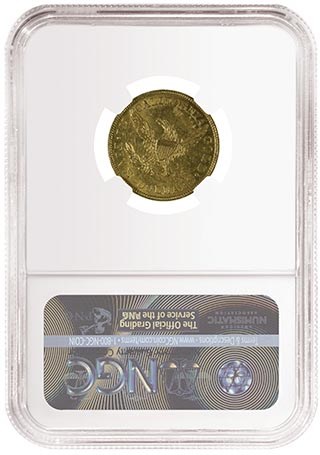NGC Certifies Rare Wass, Molitor & Co. Gold Coins from the Hungarian National Museum
Posted on 3/12/2018
Numismatic Guaranty Corporation® (NGC®) has certified three rare gold coins struck by Wass, Molitor & Co. in the 1850s during the height of the California Gold Rush. The coins were submitted to NGC’s office in Munich, Germany, by the Hungarian National Museum, which received the coins from Count Samuel Wass.
A prominent Hungarian, Wass came to the United States in 1849 during Hungary’s struggle for independence. (The unsuccessful Hungarian Revolution is so important to the people of Hungary that its start, March 15, is celebrated as a national holiday today.) In 1851, Wass moved to California and partnered with another Hungarian, Count Albert Molitor, to start a gold assay firm in San Francisco: Wass, Molitor & Co.
The firm was among several private assayers that struck coins in California in the 1850s to satisfy the state’s desperate need for circulating coinage. Wass, Molitor & Co. issued $5 and $10 gold pieces in 1852 and $10, $20 and $50 gold pieces in 1855. The designs of the coins mirrored official US gold coins but some of the legends were changed. For example, "LIBERTY" was replaced with "W.M. & Co." on the $5, $10 and $20. The $50 gold pieces, which were larger than any circulating US gold coins, featured a wreath on the reverse with the legends "WASS MOLITOR & CO. SAN FRANCISCO CALIFORNIA" around the perimeter.
The opening of the US Branch Mint in San Francisco in 1854, however, reduced the need for private assayers and their coins, which are called “Territorial Gold Pieces” by collectors. Wass, Molitor & Co. appears to have ceased operations by the end of 1855.
On August 13, 1855, Wass sent four of his coins directly from San Francisco to the Hungarian National Museum:
- An 1852 Large Head $5, now graded NGC Uncirculated;
- An 1852 Wide Date, Large Head $10, now graded NGC MS 63;
- An 1855 $20, missing since 1966 or earlier; and,
- A stunning 1855 $50, now graded NGC MS 63, which ranks as the second-finest example certified by NGC.
NGC graded the coins during its first on-site grading event at its office in Munich. The coins were encapsulated in NGC’s special Museum Holders, which were originally developed for the Smithsonian Institution and can be opened along the edge to allow the museum to examine the coins outside of the holder. NGC’s certification labels describe the coin, its grade and its illustrious pedigree.
“These coins bring history alive in a truly remarkable way, connecting us with two pivotal moments in American and Hungarian history,” says Mark Salzberg, NGC Chairman and one of the graders who evaluated the coins in Munich. “I am honored that the Hungarian National Museum chose NGC to grade these important rarities, and I am thrilled that our presence in Munich gave us such an opportunity.”
The decision to certify these coins began when Dr. Csaba Tóth, curator of the Hungarian National Museum, contacted Arthur L. Friedberg, a respected numismatic author. Mr. Friedberg referred Dr. Tóth to Douglas Mudd, the curator of the American Numismatic Association (ANA) Edward C. Rochette Money Museum. Mr. Mudd then introduced Dr. Tóth to NGC, which has previously certified coins from the ANA's collection. NGC is the official grading service of the ANA.
"This was the first time in its 200-year history that the museum chose to have coins from its numismatic collection graded," said Dr. Tóth. "As a result, we've put coins from our public collection in the spotlight. Hopefully, this will make people realize how many rare and high-grade coins are 'hidden' in museums, waiting to be discovered. I hope that this fruitful cooperation with NGC can be continued with other spectacular coins from our collection."
About the Coin Cabinet at the Hungarian National Museum
The Coin Cabinet of the Hungarian National Museum houses one of the museum’s primary collections. The third oldest museum in Europe was established by Count Ferenc Széchényi in 1802 as he donated his library, including his coin collection of 2,675 pieces, to the Hungarian nation. At present, both within and in addition to the four major collections — ancient (Greek, Celtic, Roman and Byzantine) coins, Hungarian and foreign coins, medals and paper currency (banknotes and securities) — numerous larger or smaller collection groups have arisen, such as the collections of Oriental (including Chinese and Islamic) coins, badges, awards, decorations and dies. Today, the archives lists about 350,000 objects in about 60 inventory books, ranging from primitive forms of money such as cowry shells, bronze bracelets and silver bars through the coins of the ancient, medieval and modern periods to the securities and banking cards issued in modern times. In the course of the past 200 years, the Numismatic Collection, through its collections, books and colleagues, has been a primary research center in Hungarian numismatics. To learn more, go to mnm.hu/en/collections/coins-collection
Stay Informed
Want news like this delivered to your inbox once a month? Subscribe to the free NGC eNewsletter today!






